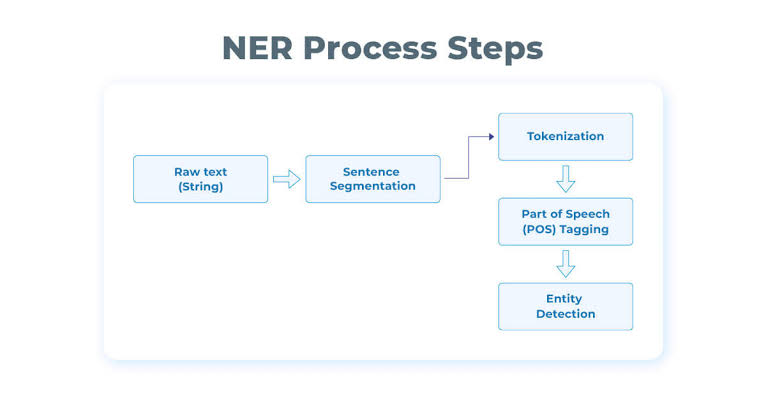Named Entity Recognition (NER) has emerged as pivotal technique in field of natural language processing (NLP). It serves as fundamental component. The task is essential in extracting structured information from unstructured text. This enables machines to understand and process human language more effectively. This essay delves into the significance of NER. It also examines its methodologies. Applications and challenges faced in its implementation are considered.
Named Entity Recognition is subtask of information extraction. It involves identifying and classifying entities within text into predefined categories. These entities typically include names of people organizations locations dates and other specific items. These hold significance within context. For example, in the sentence "Apple Inc. was founded by Steve Jobs in Cupertino in 1976." NER would identify "Apple Inc." as organization. "Steve Jobs" as person "Cupertino" as location and "1976" as date.
NER systems are designed to parse through large volumes of text. They distinguish between different types of entities. They categorize them appropriately. This capability is crucial for transforming unstructured data into more manageable and useful format. It paves the way for advanced data analysis. And decision-making processes.
Techniques and Methodologies in Named Entity Recognition
NER employs a variety of techniques to achieve accurate entity extraction. These techniques can be broadly classified into rule-based, statistical, and neural network approaches.
Rule-Based Systems
Rule-based NER systems rely on predefined rules and patterns to identify entities. These rules are often derived from linguistic knowledge, such as regular expressions and part-of-speech tagging. For instance, a rule-based system might use patterns like capitalized words or specific keywords to recognize names of people or organizations.
While rule-based systems can be effective in controlled environments with well-defined entity types, they often struggle with variability and ambiguity in natural language. The rigidity of rules may also limit their ability to adapt to new contexts or emerging entities.
Statistical Models
Statistical models, such as Hidden Markov Models (HMMs) and Conditional Random Fields (CRFs), have been widely used in NER. These models leverage probabilistic techniques to predict entity labels based on the likelihood of certain patterns occurring in the text. By training on annotated corpora, statistical models can learn patterns and dependencies that are useful for entity recognition.
Statistical models offer greater flexibility and adaptability compared to rule-based systems. They can handle a wider range of variations in language and improve their performance as more annotated data becomes available. However, they still require substantial training data and computational resources.
Neural Network Approaches
The advent of deep learning has revolutionized NER with the introduction of neural network-based approaches. Techniques such as Recurrent Neural Networks (RNNs), Long Short-Term Memory networks (LSTMs), and Transformers have demonstrated impressive performance in entity recognition tasks.
Neural networks can automatically learn complex patterns and representations from raw text data. For example, the Transformer-based models like BERT (Bidirectional Encoder Representations from Transformers) have set new benchmarks in NER by capturing contextual information and understanding the nuances of language.
These models benefit from large-scale pre-training on diverse datasets, allowing them to generalize across different domains and languages. However, they also require significant computational power and data to achieve optimal results.
Applications of Named Entity Recognition
NER has numerous applications across various domains, enhancing the capabilities of information retrieval, data mining, and content analysis.
Information Retrieval
In search engines and digital libraries, NER helps improve search accuracy by identifying and highlighting relevant entities within documents. For instance, when users search for information about a specific person or organization, NER can extract and present relevant results more effectively.
Data Mining and Analytics
For businesses and researchers, NER enables the extraction of valuable insights from vast amounts of textual data. By identifying key entities in customer reviews, social media posts, or news articles, organizations can gain a better understanding of trends, sentiment, and emerging topics.
Content Classification and Summarization
NER aids in content classification by categorizing documents based on the entities they contain. This process is essential for organizing and summarizing large volumes of text, making it easier for users to navigate and retrieve pertinent information.
Automated Customer Support
In customer support systems, NER can be used to analyze customer queries and identify key entities such as product names, issue types, or location details. This information helps route queries to the appropriate support channels and improve response accuracy.
Challenges in Named Entity Recognition
Despite its advancements, NER faces several challenges that impact its effectiveness and accuracy.
Ambiguity and Context
Ambiguity in natural language poses a significant challenge for NER systems. The same word or phrase can represent different entities depending on the context. For example, "Apple" could refer to the technology company or the fruit, depending on the surrounding text.
Contextual understanding is crucial for disambiguating entities and accurately classifying them. While neural network models have made strides in capturing context, there are still cases where subtle nuances may lead to incorrect entity recognition.
Variability and Diversity
The variability and diversity of language across different domains and languages add complexity to NER tasks. Entities may be expressed in various forms, and new entities constantly emerge. Adapting NER systems to handle this variability requires ongoing training and updates.
Data Scarcity and Quality
High-quality annotated data is essential for training accurate NER models. However, obtaining large, diverse, and well-annotated datasets can be challenging. In some languages or specialized domains, the lack of sufficient training data can hinder the performance of NER systems.
Conclusion
Named Entity Recognition plays a crucial role in transforming unstructured text into actionable information. By employing various techniques, from rule-based systems to advanced neural networks, NER enables the extraction and classification of entities that are vital for numerous applications. While challenges such as ambiguity, variability, and data scarcity persist, ongoing advancements in NLP and machine learning continue to enhance the capabilities and accuracy of NER systems. As technology evolves, NER will remain a cornerstone in the quest to make sense of the vast amounts of text data generated in our increasingly digital world.
